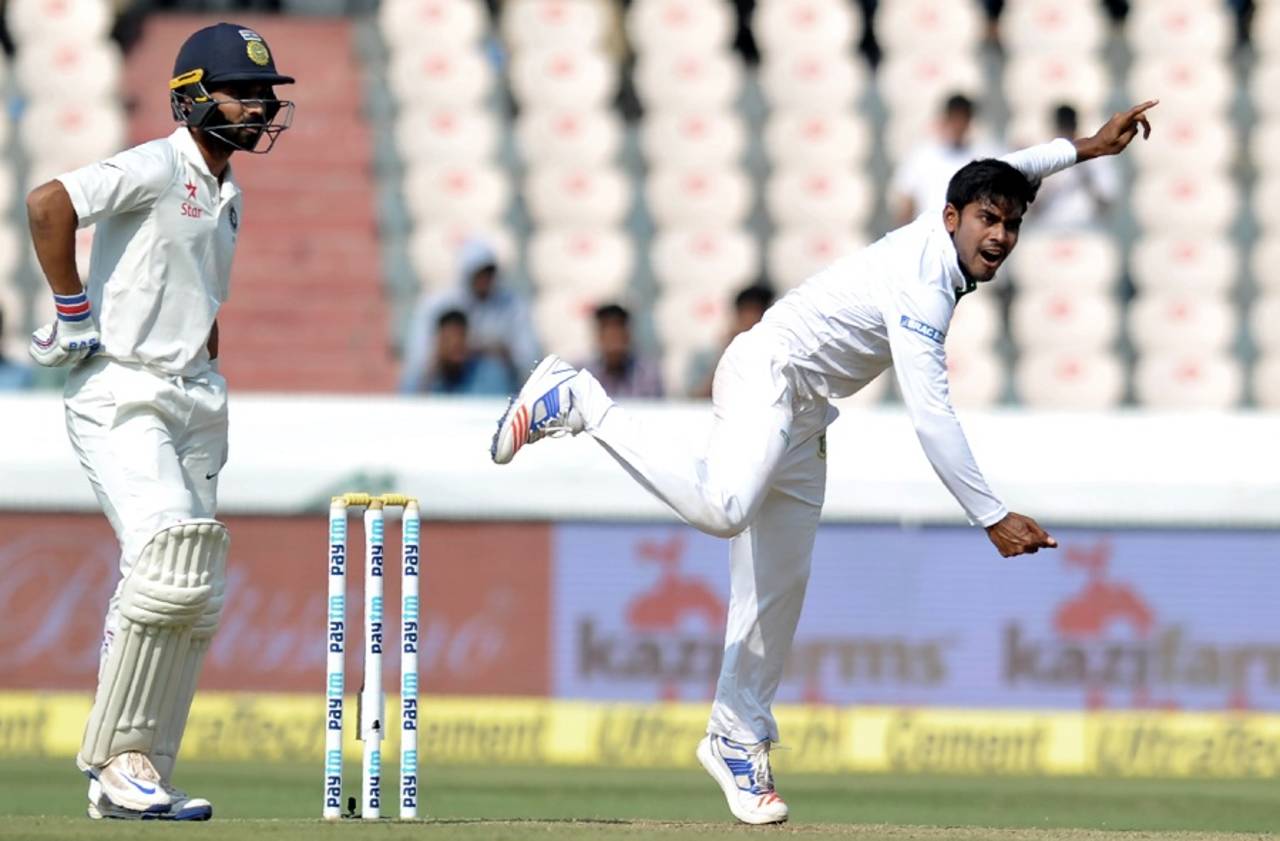Bangladesh bowl too short to exploit reverse
Aakash Chopra analyses the finer points of the first day's play in Hyderabad
Aakash Chopra
09-Feb-2017

Even on a placid first-day pitch, Mehedi Hasan kept India's batsmen wary with his line and subtle variations • AFP
Pitch report
The grass on the top and the hardness underneath suggests that the pitch is made to last five days. In fact, it was either the presence of grass or the fact that Bangladesh are expected to play spin better than either New Zealand or England did on their recent visits that led India to field three seamers. The visitors, on the other hand, have gone with three spinners.
Rahul out early
Rahul's dismissal, once again, highlighted the importance of bowling a full ball in the early part of a batsman's innings. The same ball could have been driven driven for a boundary but that's a chance a bowler must be willing to take. In this case, only the hands reached out for the ball and that resulted in the bat coming down at an angle.
Kamrul's round-arm action
Kamrul Islam Rabbi's action reminds you of Rubel Hussain. The slingy round-arm action presents a variety of challenges for the batsman, especially if you're playing him for the first time. It starts with the inability or some confusion with regards to picking the line. Since you're conditioned to pick the line based on the arm of the bowler, it takes time to get used to unlearn the basics. That's why we witnessed both M Vijay and Cheteshwar Pujara playing away from the body every now and then. The second issue is of some of the balls not landing on the seam and coming back in after pitching. While the round-arm action encourages you to play outside the line to cover the outswing, it's imperative to stay wary of the ones coming back in. Last but not least, the lack of bounce because of the lower trajectory and the ball not consistently landing on the seam makes playing the bouncer a little tough, provided they're well directed.
Mehedi Hasan's release points
The first impressions of Mehedi are of someone with a simple yet effective gameplan. On a pitch that hasn't offered anything to the spinners thus far, he's shown the maturity to maintain an outside-off line. He's also subtly changed the point of release to get a different response from the pitch. For his stock delivery, he's looked to bowl with a high-arm action and to bowl the slider, he's bowled with a slightly round-arm action.
Pujara's range on the back foot against spin
Since Pujara uses his feet to come down the pitch very often, he forces the bowlers to drag it shorter. That's when he unleashes his full range of strokes off the back foot. Besides pulling and cutting the half trackers, he's capable of placing the ball between square leg and midwicket with a straight bat and playing fine or square on the off side, depending on the length.

The length Taskin Ahmed and Kamrul Islam Rabbi bowled on day one was perhaps too short for the slow Hyderabad pitch•ESPNcricinfo Ltd
The 50th over
First signs of reverse-swing. Taskin Ahmed has got the ball to tail in sharply in the air to Pujara. It is the only way for a fast bowler to stay relevant on this pitch. Since there's no lateral movement or pace off the surface, it's imperative to extract something in the air. Unfortunately, Bangladesh seamers weren't penetrative enough to cause damage. One of the reasons for their lack of penetration was the length they bowled, which was a bit too short for the slow Hyderabad pitch.
Kohli's self-discipline
The key component of Kohli's success is his ability to assess the conditions and not allow his ego to come in the way of his gameplan. On a pitch like this, against an opposition like Bangladesh, some batsmen might end up trying things they wouldn't otherwise. But Kohli's discipline and ability to keep his ego in check puts him in a different league. His innings is reminding me of his double-hundred against New Zealand in Indore last year.
Aakash Chopra is the author of three books, the latest of which is The Insider: Decoding the craft of cricket. @cricketaakash